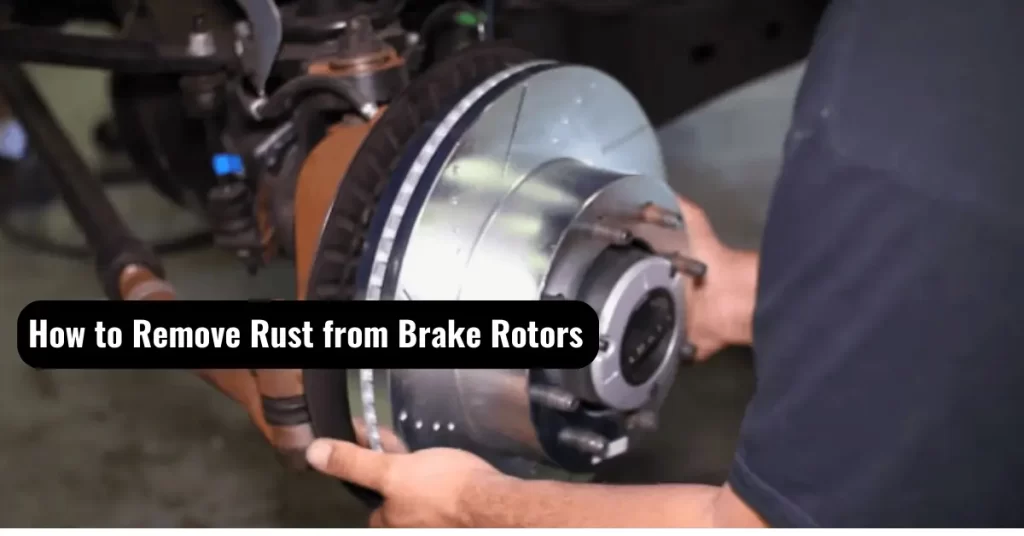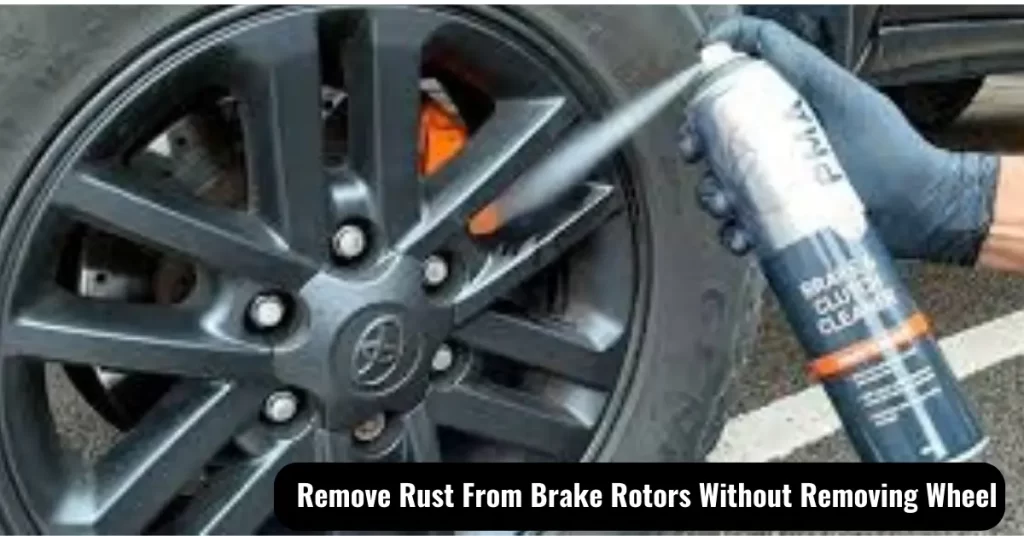How to Remove Rust from Brake Rotors?- 6 Easy Steps
Maintaining your car regularly is important not only for its aesthetic look and feel but also for its safety and security. One of the most integral components of any car is the brake rotor, which plays an important role in controlling the friction between the brakes and the wheels to help control your car’s motion. However, cleaning the brake rotors without removing them from each wheel can be difficult.
Removing all four wheels to clean your rotor can be time-consuming and impractical for many people. Fortunately, with a few basic tips, you can learn how to clean brake rotors without taking them out. This method involves using water, a degreasing solution, a wire brush, or even a steam cleaner for deep cleaning. With these simple steps, you should have cleaned your brake rotors without having to take them out.
How Do Rotors Get Rusty?
Brake rotors are an important part of a car’s braking system. They are typically made out of either cast iron or steel, which is a combination of iron and carbon. Usually, these materials are very resilient to rust and oxidation, but when exposed to certain conditions can start to break down over time. When iron combines with water, rust begins to form on the surface of the rotor. This process can be accelerated if brake rotors aren’t properly cared for.
One way brake rotors can become rusty is through exposure to salt during winter driving. During cold weather, road salts are used by municipalities to melt snow and ice on roadways. This salt then gets kicked up by passing cars and finds its way onto their brake rotors.
Over time this salt corrodes the surface of the rotor, eventually leading to rust buildup. Additionally, those living in very humid climates – especially near the ocean – have an additional risk of corrosion due to more frequent exposure to moisture in the air. This moisture makes it easier for rust and oxidation to take effect since water is one component of rust formation. To keep brake rotors from becoming rusty, ensure they’re given regular maintenance and check-ups at least once a year.
Here is How to Remove Rust from Brake Rotors

Based on the tools and materials you provided, here’s a table outlining the requirements for a brake maintenance or repair task:
| Tools Required | Materials Required |
|---|---|
| 6-inch C-clamp | Brake cleaner spray |
| Combination wrench set | Commercial cleaner or distilled white vinegar |
| Floor jack | Non-oily rags |
| Large bucket or basin | Steel wool |
| Length of pipe for handle extension (optional) | |
| Lug wrench or impact wrench and socket | |
| Tray to catch runoff | |
| Wheel chocks | |
| Wire-bristled brush |
Step 1: Getting the Right Cleaning Product
It is always a good habit to select specialized cleaning agents for the different parts of your car. Most brake cleaners come free of residue since they aim to clean away any leftover dirt from the key elements of a braking system. This means it will not leave any lingering dirt on your car rotors for the guarantee of perfect braking.
However, when it comes to rotor cleaning, always confirm that you are not using any product containing PTFE or gloss-enhancing abilities. These make the surface of your rotors slippery and affect braking significantly.
Step 2: When to Clean
It depends on the frequency and degree of usage that decides how often you should clean your brake system. Experienced drivers will check their car’s condition before and after each use. This includes a regular cleaning routine to boost its reliability and to keep dirt and dust at bay.
Understandably, you are exhausted from your ride and don’t feel like giving your car the proper treatment of a wash. Remember that this is the best time to clean your car because it prevents dirt, grime, or salt from forming and settling while corroding and damaging away.
Step 3: Say no to Contamination
Step 3 of removing rust from brake rotors is to avoid contamination. Contamination can occur when dirt, debris, or other objects come in contact with the rotor during cleaning. To prevent this, ensure the area around the rotor is clean and free of foreign objects. Use a broom to sweep away any loose debris and a damp rag to wipe away dirt and dust particles from the surface of the rotor. You can also use brake rotor rust removal spray to remove rust easily.
Step 4: Check for Any Damage before Washing
Carefully raise your vehicle with a lift or jack on leveled ground. Remove the wheels by unscrewing the lug screw to take them off.
To take off the rotor, disengage the brake caliper and its mounting bracket from the rotor by removing their bolts. This operation requires a ratchet or hex wrench, depending on the car model. Then pull the rotor off the studs; if there is too much rust, this might take some force and effort.
You need to make sure that you can clean them rigorously. Check for any sign of contaminants in each part, like stone chips and grime. Plus, ensure they are free of any damage, like oil contamination, scratches, or contortion.
If any part seems to be worn down or in poor condition, replacing them is necessary.
Step 5: Cleaning Process
You need a washcloth, brush, and a scrubber with abrasive material to remove any dirt and grit. Use a brake cleaner or fluid with rustproof features; spray it directly on each rotor side. To get rid of rust stains, first, remove the brake components to ensure you can clean them.
Then spray a brake cleaner thoroughly on the brake area. Rub the rusted area with steel wool or wire brush. Scrub and clean them vigorously, ensuring no trace is left and the area becomes spotless and shiny. In hard-to-reach areas, you might need small brushes such as a toothbrush.
You might repeat this step for other braking system parts like calipers. Just spray over them generously and scrub them with an abrasive material to remove any contaminants. On the other hand, you can also use white vinegar for cleaning. Pour white vinegar into a bucket and dip the rotors in it. Ensure it is completely soaked, and keep it away for 1 hour.
After 1 hour, bubbles will start to form. So take it out and wipe it clean with a cloth. If your rotors are excessively rusty, then soak them overnight and finish the process. Regardless of any car model you own, cleaning is simple and the same for all. Just make sure that you are in a well-ventilated room or outside. Also, ensure there isn’t any dirt or grit within the machine so that it can work perfectly.
Step 6: Back to Reassembling
Another way to avoid or remove rust is by driving at a low speed of 5mph or 10mph. Take your car into an area with sufficient space and no cars are present. When you hit the brakes while driving, you are typically pressing on the brakes gently. This doesn’t give enough force to make the calipers grip and remove rust. So, consider adding more pressure to the brake pedal for this process to work effectively. This won’t damage your car nor harm you and your car unless you crash onto something (You know what I mean).
How To Remove Rust From Brake Rotors Without Removing Wheel?

Removing rust from brake rotors without removing the wheel can be tricky, as the rotors are located behind the wheel and may be difficult to access. However, with the right tools and cleaning materials, you can easily remove rust from your brake rotors without taking them off. There are how to remove rust from brake rotors without removing the wheel.
Vinegar is the ideal solution to effectively clean brake rotors without removing the wheel. Mix water and vinegar, then vigorously spray the solution onto the rotor with a spray bottle. Allow the vinegar to sit for a few minutes, then thoroughly rinse it off with water and a clean rag. This method will ensure your brake rotors are spotless and functioning optimally.
Frequently Asked Questions
Is it necessary to remove rust from brake rotors?
Yes, removing rust from brake rotors is important for maintaining optimal braking performance. Rust can negatively impact the braking efficiency and cause noise, vibration, and uneven wear on the brake pads.
Can I remove rust from brake rotors without removing them from the vehicle?
Yes, removing rust from brake rotors without removing them from the vehicle is possible. However, taking proper safety precautions and using appropriate tools to access and clean the rotors effectively is important.
Can I use sandpaper instead of steel wool or a wire brush?
While sandpaper can be used, it is generally recommended to use steel wool or a wire brush for removing rust from brake rotors. They are specifically designed for this purpose and provide better results without causing damage to the rotor surface.
Will removing rust from brake rotors solve brake noise issues?
While removing rust can help reduce brake noise caused by rust buildup, it may not eliminate all noise-related issues. If you continue to experience brake noise after removing rust, it is recommended to have the brake system inspected by a professional.
How often should I remove rust from brake rotors?
The frequency of rust removal from brake rotors depends on various factors such as climate, usage, and storage conditions. It is generally recommended to inspect the brake rotors regularly and remove rust as soon as it accumulates to prevent further deterioration of the braking system.
Conclusion
Rust can easily accumulate on brake rotors from regular use and exposure to moisture. Removing rust from brake rotors to maintain optimal brake performance is important. Removal of rust can be done without removing the wheel, using vinegar, water, a spray bottle, and steel wool or a wire brush. Finally, inspecting the brake rotors regularly and removing rust as soon as it starts to accumulate is recommended.
